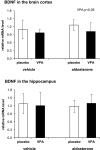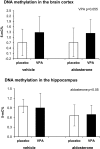Brain derived neurotrophic factor expression and DNA methylation in response to subchronic valproic acid and/or aldosterone treatment
- PMID: 31044578
- PMCID: PMC6509635
- DOI: 10.3325/cmj.2019.60.71
Brain derived neurotrophic factor expression and DNA methylation in response to subchronic valproic acid and/or aldosterone treatment
Abstract
Aim: To test the hypothesis that valproic acid treatment positively affects brain-derived neurotrophic factor (BDNF) expression and DNA methylation in the hippocampus and brain cortex of rats simultaneously treated with aldosterone.
Methods: Male Sprague-Dawley rats (N=40) were treated for two weeks with valproic acid (100 mg/1 kg body weight/d) in drinking water and aldosterone (2 μg/100 g body weight/d) or placebo via subcutaneous osmotic minipumps.
Results: Treatment with valproic acid did not modify BDNF gene expression in the hippocampus but reduced BDNF mRNA levels in the brain cortex. Valproic acid treatment marginally enhanced global DNA methylation in the frontal cortex. BDNF expression negatively correlated with DNA methylation in the hippocampus of valproic acid-treated rats. An unexpected finding was that aldosterone treatment significantly decreased global DNA methylation in the hippocampus.
Conclusion: The effect of valproic acid on BDNF expression in the brain may depend on the extent of pathological changes present at the time of treatment onset. The observed negative correlation between BDNF expression and DNA methylation in the hippocampus of valproic acid-treated rats encourages further studies.
Figures



Similar articles
-
Inhibition of DNA Methylation in the Developing Rat Brain Disrupts Sexually Dimorphic Neurobehavioral Phenotypes in Adulthood.Mol Neurobiol. 2017 Aug;54(6):3988-3999. doi: 10.1007/s12035-016-9957-4. Epub 2016 Jun 16. Mol Neurobiol. 2017. PMID: 27311770 Free PMC article.
-
[Effect of acupuncture on expression of brain-derived neurotrophic factor gene and protein in frontal cortex and hippocampus of depression rats].Zhen Ci Yan Jiu. 2012 Feb;37(1):20-4. Zhen Ci Yan Jiu. 2012. PMID: 22574564 Chinese.
-
Repeated treatment with mirtazepine induces brain-derived neurotrophic factor gene expression in rats.J Physiol Pharmacol. 2005 Dec;56(4):661-71. J Physiol Pharmacol. 2005. PMID: 16391422
-
The cognitive impairment induced by zinc deficiency in rats aged 0∼2 months related to BDNF DNA methylation changes in the hippocampus.Nutr Neurosci. 2017 Nov;20(9):519-525. doi: 10.1080/1028415X.2016.1194554. Epub 2016 Jun 22. Nutr Neurosci. 2017. PMID: 27329329
-
Epigenetic histone acetylation and Bdnf dysregulation in the hippocampus of rats exposed to repeated, low-dose diisopropylfluorophosphate.Life Sci. 2021 Sep 15;281:119765. doi: 10.1016/j.lfs.2021.119765. Epub 2021 Jun 26. Life Sci. 2021. PMID: 34186043
Cited by
-
Exposure to chronic stressor upsurges the excitability of serotoninergic neurons and diminishes concentrations of circulating corticosteroids in rats two weeks thereafter.Pharmacol Rep. 2022 Jun;74(3):451-460. doi: 10.1007/s43440-022-00366-z. Epub 2022 Apr 15. Pharmacol Rep. 2022. PMID: 35428937
-
Delta-Opioid Receptors Play a Role in the Control of Selected Parameters Related to Stress and Brain Plasticity Under Non-stress and/or Stress Conditions.Cell Mol Neurobiol. 2022 Jan;42(1):137-146. doi: 10.1007/s10571-021-01067-6. Epub 2021 Mar 8. Cell Mol Neurobiol. 2022. PMID: 33683529 Free PMC article.
-
Food Enrichment with Glycyrrhiza glabra Extract Suppresses ACE2 mRNA and Protein Expression in Rats-Possible Implications for COVID-19.Nutrients. 2021 Jul 6;13(7):2321. doi: 10.3390/nu13072321. Nutrients. 2021. PMID: 34371831 Free PMC article.
-
Unveiling Molecular Dynamics of MeCp2, CDKL5 and BDNF in the Hippocampus of Individuals With Intractable Mesial Temporal Lobe Epilepsy.J Cell Mol Med. 2025 Feb;29(3):e70373. doi: 10.1111/jcmm.70373. J Cell Mol Med. 2025. PMID: 39888294 Free PMC article.
-
The new mechanism of cognitive decline induced by hypertension: High homocysteine-mediated aberrant DNA methylation.Front Cardiovasc Med. 2022 Oct 24;9:928701. doi: 10.3389/fcvm.2022.928701. eCollection 2022. Front Cardiovasc Med. 2022. PMID: 36352848 Free PMC article. Review.
References
-
- Dussaule C, Bouilleret V. Psychiatric effects of antiepileptic drugs in adults. Geriatr Psychol Neuropsychiatr Vieil. 2018;16:181–8. - PubMed
MeSH terms
Substances
LinkOut - more resources
Full Text Sources
Medical

